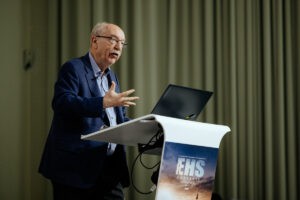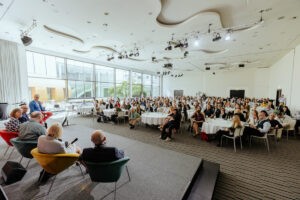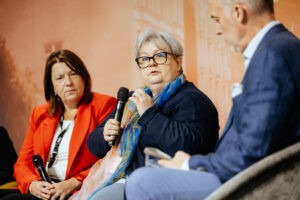CONFERENCE REVIEW
EHS Congress 2024, Berlin – ‘Good people want to do the right thing.’
The recent EHS Congress covered communication, community and (fast) cars. SHP Editor Mark Glover travelled to Germany for the event.
EHS Congress 2024 in Berlin played out to over 300 people over two days, representing over 190 organisations. Chaired as ever by Andrew Sharman, the two-day event had over 40 hours of sessions, with an array of workshops splintering off with the likes of Diane Chadwick-Jones and Sydney Dekker.
Deep thinking
A highlight of the first morning was Dr Gerd Gigerenzer. The respected author and academic was making his first appearance at the Congress and his theories

Author and academic Dr Gerd Gigerenzer presenting in Berlin
around deep thinking are relevant to, but resonate beyond the safety sphere, forcing delegates to think outside the norm. He unpacked the trope of defensive decision-making, common among managers who might call a situation they feel is best for the company, but pursue a second option in order to protect themselves. Ultimately, Dr Gigerenzer explained, this is only to the organisation’s detriment.
Time for a pit stop
That same day Stuart Hughes put down his IOSH President hat and focused on the day job in his presentation. Hughes is health and safety manager at Mercedes-AMG Petronas Formula One Team and he shared a video of rivals McLaren delivering a world record pit stop of a remarkable 1.8 seconds, before showing the same team at fault in the same race, taking a costly five seconds that would ultimately hand the championship to Hughes’ team Mercedes,
But what did the story mean in the context of this conference? What would a HS Manager takeaway from this slice of F1? With some cars coming in for two or three times a race, hughes explained how consistently quick pit stops can mould a winning race strategy. He suggested a true and steady approach can also be applied in communication between Manager and worker. “They [the worker] get the consistency in approach; they get the consistency in response; they got the consistency in being heard,” he said.
The message is valid. Consistent clear communication is paramount regardless of environment, be it the manufacturing floor or the race track.
Professors to practitioners
What role does academia play in the EHS profession? It was a topic of discussion two years ago and the thread was revisited on the morning of the second day, and again the question remained how to close the gap between professors and practitioners.
It’s unlikely a technical 10,000-word paper on safety culture will chime with most health and safety professionals who are already wrestling an ever-increasing to-do list.
“There’s an enormous amount of academic research that is dense, deep and complex,” Sharman said, introducing a panel debate on the topic. “I hear from an awful lot of practitioners that it’s hard to understand what the academics are really trying to tell us.”
Sharman is well-placed to comment. His work as a consultant means he is a soundboard to these challenges from those who are keen to implement a certain theory, but unsure how. Yet, the influence of academic research runs strong through safety’s DNA, with many theories becoming the backbone of an organisation’s safety strategy.
The next big thing?

The panel discuss academic and practitioner collaboration
Those on the panel tasked with unpacking the topic the previously mentioned Dr. Gigenrenzer; Dianne Parker, Director at Safety Culture Associates; author and academic Erik Holnagel; Dr Drew Rae, Safety Professor at Griffiths University, Australia; Professor Rhona Flin, from the University of Aberdeen and Dianne Parker, Director at Safety Culture Associates.
Dr Parker addressed the disconnect as a lack of genuine innovation in thinking. Often theories are spun as the latest insight but on closer inspection they just mirror what’s gone before. “Quite often, if you’ve been in the business long enough you’ll see that the next big thing is the same as the big thing before last, but just packaged differently,” she said, “but the people who are working in industry trying to get a lead from the consultants or academics are thinking, ‘How can I grasp and get my head round all these competing models?”
Dr Rae attempted to put forward a middle ground where safety professionals become “a critical consumer of research” as it is for other professions such as teachers, doctors and nurses. Today, he said, safety professionals “have a strong culture of engaging with the research except at a superficial level”.
Warming to the topic he questioned if academic theories are pursued for the right reason. “Professionals should have a culture of engaging with the research not because their manager says so, but because the evidence says it will be a good thing for this certain situation,” he said.
Evidence-based research comes from a foundation of robust use-case examples; which in turn comes from collaboration and partnerships. Dr Flin urged the audience to make the fist move in order to reap the rewards. “The academics are usually very happy to hear from pracitioners…and as you build these relationships, that’s a very good way of learning what the evidence is.”
Internal and external conflict
“What causes people to be unwell is other people,” Dr Rod Gutierrez told the audience in one of the first sessions of day two. His statement was used as a foundation of discussion for a debate on the profession’s responsibility to the community and also workforce wellbeing. Steering the conversation, Chair Andrew Sharman followed up the statement by asking if the quote resonated with the panel.
“We’re seeing an increase in violence and aggression to our frontline employees,” said Amanda Owens MBE, Health, Safety and Wellbeing Director at Heathrow. Since Covid people are angry and they’re anxious and an airport puts them through a process that is outside of their control.”

(L-R) Amanda Owens, Jane Foley, Andrew Sharman
It means workers are often exposed to conflict, an experience that can have an impact on mental health. However, with a nod to Gutierrez’s quote, she said conflict can also come from within, for example from another colleague and the impact can be just as detrimental.
To negate this, Owens explained how she and her team put their managers through a mental fitness programme to provide them as much as possible the skills required to support staff dealing with conflict from both sides of work.
Duty of care as a human being
Panelists acknowledged that the pandemic has created a new hybrid world of work; enabling employees to build more flexibility into their hours, and help build a more positive work/life balance. Yet, legislation and regulation around home working remains rather woolly, particularly when it comes to duty of care, something that Mary Foley at ENHESA had concerns around. “What risks are they [employees] leavings themselves open to?” she asked, “Where does the duty of care end or being?”
For Owens, the impact of lockdown, when the aviation sector was literally grounded with many staff put on furlough, exposed some to a risk that she had not considered – domestic violence. “To many of us it was a tragic relevation,” she recalled, “So of course we didn’t furlough them. We tried to support them in terms of our duty of care to them as a human being.” As such, Heathrow have not and continue to not mandate home working, with the office open daily for those who wish to come in. In such an extreme situation, Owens was able to clarify duty of care quite easily, that it’s about simply helping someone who is in danger.
Mantra
“Good people want to do the right thing,” Owens told the audience, finishing the anecdote.
It’s a mantra that summarises the ethos of the EHS Congress, its delegates and ultimately the profession.
In December the EHS Congress is coming to London, co-locating with Anticipate. More information can be found here.
EHS Congress 2024, Berlin – ‘Good people want to do the right thing.’
The recent EHS Congress covered communication, community and (fast) cars. SHP Editor Mark Glover travelled to Germany.
Mark Glover - SHP Editor
SHP - Health and Safety News, Legislation, PPE, CPD and Resources Related Topics
Lessons from down under: Psychological safety enshrined in the law
Ever thought you could give Gareth Southgate a run for his money? What the world of health, safety and wellbeing can learn from sport
Human performance actions speak louder than words



